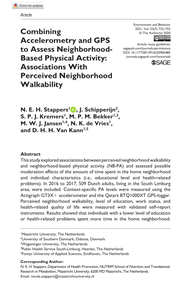This study explored associations between perceived neighborhood walkability and neighborhood-based physical activity (NB-PA) and assessed possible moderation effects of the amount of time spent in the home neighborhood and individual characteristics (i.e., educational level and health-related problems). In 2016 to 2017, 509 Dutch adults, living in the South Limburg area, were included. Context-specific PA levels were measured using the Actigraph GT3X+ accelerometer and the Qstarz BTQ1000XT GPS-logger. Perceived neighborhood walkability, level of education, work status, and health-related quality of life were measured with validated self-report instruments. Results showed that individuals with a lower level of education or health-related problems spent more time in the home neighborhood. The perceived neighborhood walkability only affected NB-PA for individuals spending a relatively large amount of time in their home neighborhood. PA-facilitating features in the home neighborhood, for example, aesthetics, were only associated with more NB-PA for individuals without health-related problems or with a higher level of education.
DOCUMENT

DOCUMENT

Background: The worldwide increase in the rates of childhood overweight and physical inactivity requires successful prevention and intervention programs for children. The aim of the Active Living project is to increase physical activity and decrease sedentary behavior of Dutch primary school children by developing and implementing tailored, multicomponent interventions at and around schools. Methods/design: In this project, school-centered interventions have been developed at 10 schools in the south of the Netherlands, using a combined top-down and bottom-up approach in which a research unit and a practice unit continuously interact. The interventions consist of a combination of physical and social interventions tailored to local needs of intervention schools. The process and short- and long-term effectiveness of the interventions will be evaluated using a quasi-experimental study design in which 10 intervention schools are matched with 10 control schools. Baseline and follow-up measurements (after 12 and 24 months) have been conducted in grades 6 and 7 and included accelerometry, GPS, and questionnaires. Primary outcome of the Active Living study is the change in physical activity levels, i.e. sedentary behavior (SB), light physical activity (LPA), moderate-to-vigorous physical activity (MVPA), and counts-per-minute (CPM). Multilevel regression analyses will be used to assess the effectiveness of isolated and combined physical and social interventions on children’s PA levels. Discussion: The current intervention study is unique in its combined approach of physical and social environmental PA interventions both at school(yard)s as well as in the local neighborhood around the schools. The strength of the study lies in the quasi-experimental design including objective measurement techniques, i.e. accelerometry and GPS, combined with more subjective techniques, i.e. questionnaires, implementation logbooks, and neighborhood observations. LinkedIn: https://www.linkedin.com/in/sanned/
DOCUMENT
